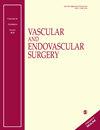双工快速颈动脉筛查:一项前瞻性单中心评估
IF 0.7
4区 医学
Q4 PERIPHERAL VASCULAR DISEASE
引用次数: 0
摘要
目的建立一种新的颈动脉快速扫描(CQS)方案,用于快速筛查门诊血管狭窄超过50%的颈动脉粥样硬化。这项研究评估了准确性和节省的时间。材料,方法采用改进的德尔菲法,经血管外科医生和临床血管专家一致同意,编制CQS。该方案包括对颈总动脉和颈内动脉进行快速b型彩色血流横向扫描,并进行颈内动脉速度评估。研究招募了100名外周动脉疾病或腹主动脉瘤门诊患者。CQS的敏感性、特异性和准确性根据传统的全颈动脉双工研究进行评估,并按照英国和ESVS指南进行。结果100例患者中颈动脉狭窄率达50%,占24%。与全双工相比,CQS检测>50%狭窄的准确率为96.5%;Cohen 's本文章由计算机程序翻译,如有差异,请以英文原文为准。
Rapid Carotid Screening by Duplex: A Prospective Single Centre Assessment
Objective A novel carotid quick scan (CQS) protocol was developed to rapidly screen for carotid atherosclerosis greater than 50% stenosis in a vascular outpatient setting. This study assessed accuracy and time saved. Material & Methods The CQS was developed by consensus agreement between vascular surgeons and accredited clinical vascular scientists through a modified Delphi technique. The protocol comprised a rapid B-mode then colour flow transverse sweep of the common and internal carotid arteries, with internal carotid artery velocity assessment. One hundred outpatients attending with peripheral artery disease or abdominal aortic aneurysm were recruited. CQS sensitivity, specificity and accuracy was assessed against a conventional full carotid duplex study, performed to UK and ESVS guidelines. Results Twenty four percent of patients (n = 100) had >50% carotid NASCET stenosis. CQS achieved an excellent accuracy of 96.5% in detecting >50% stenosis when compared to full duplex; Cohen’s ƙ = .88, (95%CI .79-.97; P < .001), sensitivity 91.4%, specificity 97.6%, positive predictive value (PPV) 88.9% and negative predictive value (NPV) 98.2%. Median (IQR) time to complete the CQS was 13 sec (±12) per side, compared to 151 sec (±78) per side for the full carotid duplex. In the presence of >50% carotid disease, median CQS time was 25 sec (±31) per side compared to 214 (±104) by full scan. Conclusion CQS as a carotid screening tool is rapid, accurate and acceptable to the population and workforce. It would be simple to roll out in all vascular laboratories to reduce the time and cost burden of excluding significant carotid disease in any group.
求助全文
通过发布文献求助,成功后即可免费获取论文全文。
去求助
来源期刊

Vascular and Endovascular Surgery
SURGERY-PERIPHERAL VASCULAR DISEASE
CiteScore
1.70
自引率
11.10%
发文量
132
审稿时长
4-8 weeks
期刊介绍:
Vascular and Endovascular Surgery (VES) is a peer-reviewed journal that publishes information to guide vascular specialists in endovascular, surgical, and medical treatment of vascular disease. VES contains original scientific articles on vascular intervention, including new endovascular therapies for peripheral artery, aneurysm, carotid, and venous conditions. This journal is a member of the Committee on Publication Ethics (COPE).
 求助内容:
求助内容: 应助结果提醒方式:
应助结果提醒方式:


